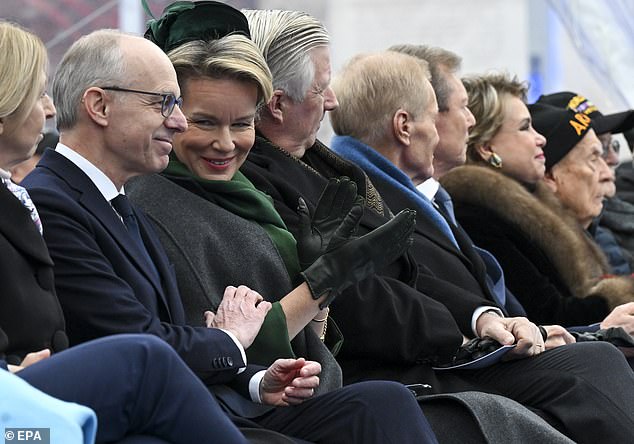Queen Mathilde of Belgium was photographed today attending a ceremony commemorating the Battle of the Bulge in Luxembourg.
She joined her husband, King Philippe, and other prominent figures, including Luxembourg Prime Minister Luc Frieden, for the event at the Hamm American Military Cemetery.
The royal, 51, wore a green and gray ensemble as the couple commemorated the 80th anniversary of the event, also known as the Ardennes Counteroffensive, in Bastogne, Belgium.
Today’s ceremony honored the memory of American soldiers who were wounded or killed during the battle, which took place from December 16, 1944 to January 25, 1945.
The Queen looked elegant as she paid tribute at the event, wearing a green dress, with matching hat and gloves, topped with a gray cape.
Meanwhile, King Philip put on a black suit, with a double-breasted jacket and combined it with a white shirt and black tie.
Other attendees included Grand Duke Henri, Grand Duchess Maria Theresa of Luxembourg and others.
Also present were the United States ambassador to Luxembourg, Thomas M. Barrett, and the deputy head of the mission, Michael Konstantino.
Queen Mathilde of Belgium is pictured while attending an event to commemorate the 80th anniversary of the Battle of the Bulge.
The Battle of the Bulge was the last major German offensive campaign on the Western Front during World War II and is known to be one of the turning points of World War II.
200,000 German soldiers counterattacked across the front line in Belgium and Luxembourg.
They crashed into battle-weary American soldiers, positioned in terrain as foreign to them as it was familiar to the Germans.
Nazi leader Adolf Hitler hoped the advance would change the course of World War II by forcing American and British troops to sue for peace, thus freeing Germany to concentrate on the rapidly advancing Soviet armies in the east.
The battle, which lasted over a month, saw the Allied forces gain the upper hand in the end and invade Germany.
It left many experienced German units severely depleted of men and equipment, while the survivors retreated to the defenses of the Siegfried Line. The war in Europe ended less than five months later.
Germany is now an ally of the United States and its wartime partners, united in the NATO alliance.
The Battle of the Bulge gained fame not so much for the tactics of the commanders but for the resistance of small units hampered by poor communications who stood shoulder to shoulder to deny Hitler the rapid advance he so desperately needed.

Queen Mathilde of Belgium (pictured, center) speaks with Luxembourg Prime Minister Luc Frieden (pictured, left).

A cannon salute was performed during today’s memorial service at the Hamm US Military Cemetery (pictured)

King Philippe and Queen Mathilde of Belgium pictured as they attend the ceremony today in Luxembourg.

The Grand Duchess of Luxembourg Maria Theresa (pictured, left) also attended the event (seen with Queen Mathilde of Belgium)
Although the Americans were often repulsed, they were able to delay the German advance in its crucial initial stages.
When the fortunes of the war turned, it was most visible in the southern Ardennes town of Bastogne, where surrounded American troops were isolated for days with little ammunition and food.
When Brig. General Anthony C. McAuliffe of the 101st Airborne Division was given an ultimatum on December 22 to surrender or face total destruction, and he offered one of the most famous (and brief) responses in military history.
He simply responded by saying, “Nuts.”
Four days later, American troops broke the Nazi siege.

